Game Flow, Part One (Dissecting Indiana Jones and the Fate of Atlantis Part 2)
(This article is part of the Dissecting Indiana Jones and the Fate of Atlantis series)
Typical Adventures increase the complexity and difficulty of the game gradually and like movie scripts, they often have several distinct parts. Atlantis is no difference, although the acts aren’t clearly marked in the game.
From a high level perspective, the game has these parts:

Atlantis is one of the most complex Adventure games because it has three different paths through the middle section. A lot of Adventure games have multiple solution to individual puzzles, but the paths make so much use of conditional logic and global state variables, the complexity is a lot higher than in other Adventures. According to Wikipedia, adding the paths added an additional 6 month and turned it into a 2 year project, so that cost was significant.
In future posts I’m going to go more into handling state and how the paths work, but for now I want to focus on the high level game flow, specifically on the “Find Plato’s Lost Dialogue” path, henceforth called “Act 1” (The game doesn’t name its acts).
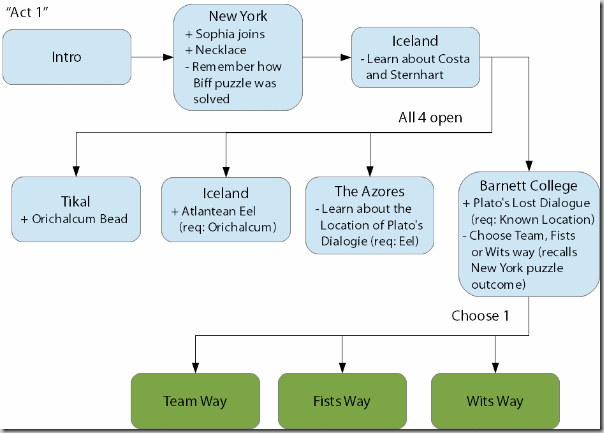
New York
The game starts out in a single location with a single room, New York. The very first puzzle requires you to get access to the theatre. Of course, tickets are sold out. There are three solutions to the puzzle, and the game remembers which one you’ve taken for some important flavor at the end of this act:
- You can knock on the door, insult the bouncer and start a fist fight.
- You can knock on the door, and praise Sophia Hapgood, the bouncer’s idol. He will let you in since you’re okay for a college boy, pal!
- You can ignore the door and push some crates to gain access to the fire exit ladder.
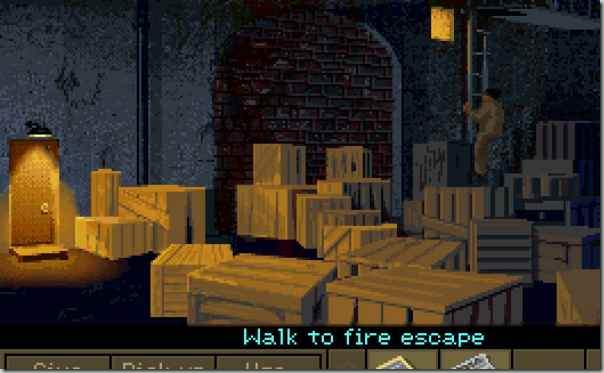
The next room contains the stage hand, which needs to be distracted. The necessary news paper can be found at the street we arrived from, so this puzzle takes place in two rooms but in a single location.
Iceland, First Visit
We’re automatically going to Iceland where we have to talk to Dr. Heimdall and learn about Dr. Sternhart in Tikal and Mr. Costa on the Azores. Once we have learned about these two people, we have multiple locations to travel to: Tikal, Iceland, The Azores and Barnett College, and no clear indication which one should be first.
Atlantis has very gradually increased complexity on us, and at this point the player needs to make choices where to go to and quite likely they will run into a few dead ends. What is important is that even though we have 4 locations, there is only one very linear way to go through this, and each location is essentially self-contained.
Tikal: Sophia is more than just an attachment…
The correct way through this linear progression starts in Tikal. Once inside the temple, the player will need to involve Sophia to advance as she needs to keep Dr. Sternhart busy so that Indy can steal the kerosene lamp.
While the concept of multiple characters isn’t new (Maniac Mansion had three, Zak McKracken had four characters), novice players may not be aware that Sophia is more than just an attachment and Tikal allows to find out about this in a very natural way (as Sternhart will always catch Indy when he tries to take the lamp, it feels very natural to ask Sophia for help).
Another small thing that Tikal introduces is manipulating items in the inventory. Before, you just gave the newspaper to the stagehand, but here you need to open the kerosene lamp and then use it on the spiral on the wall. This is a tiny detail, but remarkable nonetheless.
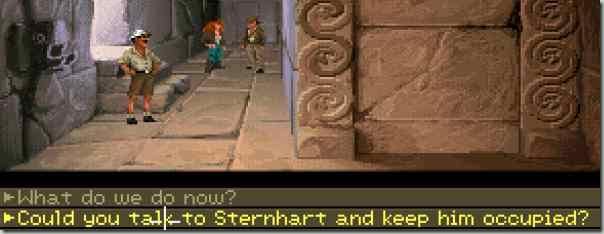
Iceland, Second Visit
In Iceland, Dr. Heimdall has frozen to death, and the frozen eel figurine is partially exposed at the head. This is significant for two reasons: First, the player is supposed to remember that in New York, Sophia put an Orichalcum bead inside the mouth of her necklace (which looks like a face) and awesome stuff happened. So the mental connection should be “Get Orichalcum and come back!”
The second reason is that Iceland is a very small location and the player already visited it, so it might feel stale at this point. As grim as it is, having Heimdall frozen helps the location to not feel boring as it changed between visits.
The Azores: …she is a real character
With the Eel in hand, the Azores can be tackled. Mr. Costa bluntly sends Indy away. Previously in Tikal, the player could talk to Sophia and ask her to distract Sternhart, which serves as a clue on how to proceed here.
It is not immediately obvious that Costa might react differently to her than to Indy, and Tikal helped in having the player naturally try talking to her (instead of just trying out everything and stumbling on the "Talk to Sophia” option)
When Indy asks her to take over, the player can control her as a real character. This is once again introducing a new concept gradually and solving one half of the puzzle here.
The second half can be solved by looking at the dialogue: Costa wants to trade, but the necklace is not an option. The player may (and should) recall the eel figurine in the ice from the first visit to Iceland (Heimdall even spoke about it, and the player HAD to go through the dialogue explaining the figurine before they could advance).
Exchanging the eel figurine for information about the location sends the player to Barnett College.
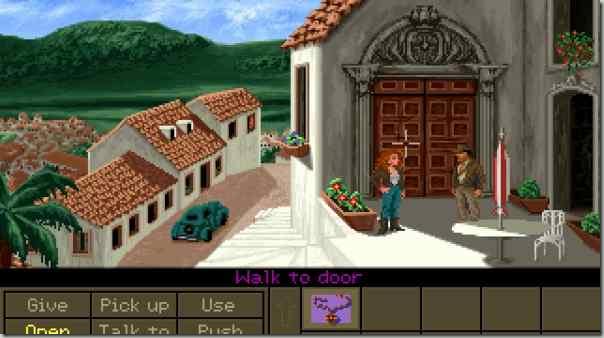
Barnett College: The most complex puzzle yet, softened through the intro
So up until this point, every location was self-contained with the exception of a single thing that needed to be done in one location in order to solve the next one.
The choice of four locations is an illusion but it keeps the player busy exploring and makes the game longer without feeling stretched out.
Barnett College, contains a (relatively) complex puzzle, the final puzzle in this act. Also, the location of Plato’s lost dialogue changes in every playthrough. There are three different locations where the Dialogue might be:
- In a chest, which requires a key from the room above
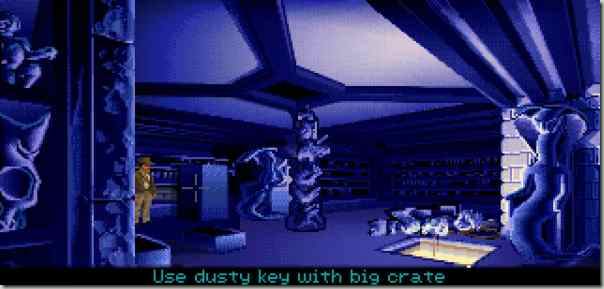
- In the tipped-over bookcase in the library (there are two ways to get it)
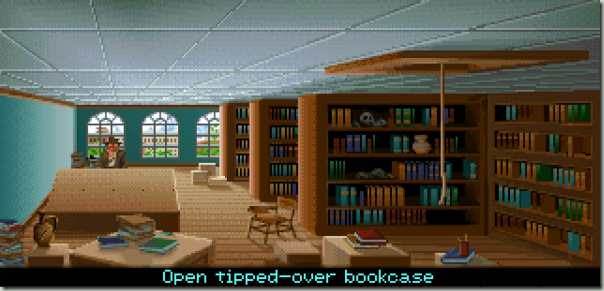
- In one of the cat figurines

The player is already familiar with the location (remember, we went through it in the intro), so the fact that we have a whopping six possible rooms with items that need to be carried between is softened a bit by the familiarity.
We may need the mayonnaise from the office to move the totem pole and climb up to the attic, get the key fro, the urn, go down again, move the big box and open the chest.
We may need to grab the arrowhead from this room and combine it with the rag from the boiler room so that we can unscrew the back of the library bookcase and get the book. In this case, combining the rag and arrowhead to create a screwdriver is the first use of combining inventory items in the game.
We may need to grab the gum from the desk in the library and use it to go up the coal chute (after we grabbed a piece of coal) and then either throw the coal at the dangling book to get it down, or we may need to get a wax cat figurine and smelt it in the furnace below.
Again, gradual increase, softened through familiarity with the location, but nevertheless a bump from previous puzzles.
After this puzzle is solved, the player has to choose one of the three paths through Act 2 (again, the game doesn’t indicate acts, I’m making this up). Sophia will recommend a path. Remember above when I said that the game remembers how Indy got into the theatre?
- If he went through the crates and took the fire ladder, Sophia will recommend the Wits path
- If he praised Sophia in front of Biff, Sophia will recommend the Team path
- If he beat Biff in a fistfight, Sophia will recommend the Fists path
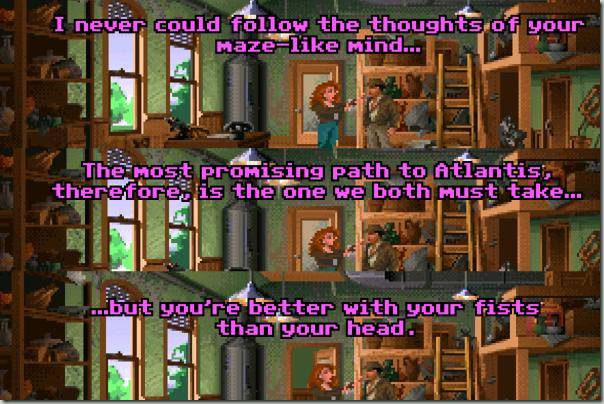
This is only a recommendation, the player is free to choose any of the three paths right now. Still, it is remarkable how the game tries to learn about the player and then tailor the rest of the game to them, but without committing at the beginning as to not punish a player that has gotten into the fistfight with Biff by accident or decided that they didn’t like fighting.

Act One: Maybe one of the best learning curves in any game, ever.
Some of the things you have read may seem obvious and have you go “Well, duh!”. But I’m trying to see how the game caters to first time gamers who may not be familiar with computers or games (remember, this was in 1992).
The first act very gradually introduces new elements, forcing the player to go through a linear progression that seemingly opens up, but really only turns into a wider tunnel instead of an intersection. Things that are important later on are clearly shown in advance and the player can remember them later (which seems to be an application of Chekhov’s gun in games).
Remembering how you deal with Biff and offering that as a choice hasn’t been repeated in mainstream adventures (with the notable exceptions of Fahrenheit and Heavy Rain), presumably because it adds so much extra work for something that a lot of players will never see – before writing this series, I never went through the Fists path for example.
(Sidenote: There was a big discussion about linearity vs. open world when Final Fantasy XIII was released, since it was very linear. Development costs for games have exploded over the past few years, and making expensive optional content is a concern for the bottom line, no doubt about that.)
In a way, the different paths act as difficulty levels as well. The Wits path may have the hardest puzzles, but is very light on fights. The Fists path is the opposite, and it adds difficulty because of two opponents that are immune to the sucker punch (Keypad 0, will instantly knock out an opponent). The Team Path is a nice balance and is a bit more dialogue heavy.
The beginning of the game introduces every individual element of the game in isolation (and there are quite a few elements if you look at it) and it does so without feeling like a limited tutorial. It encourages safe experimentation and discovery, so at the end, the player should be well prepared for the next part, which is the meat of the game.